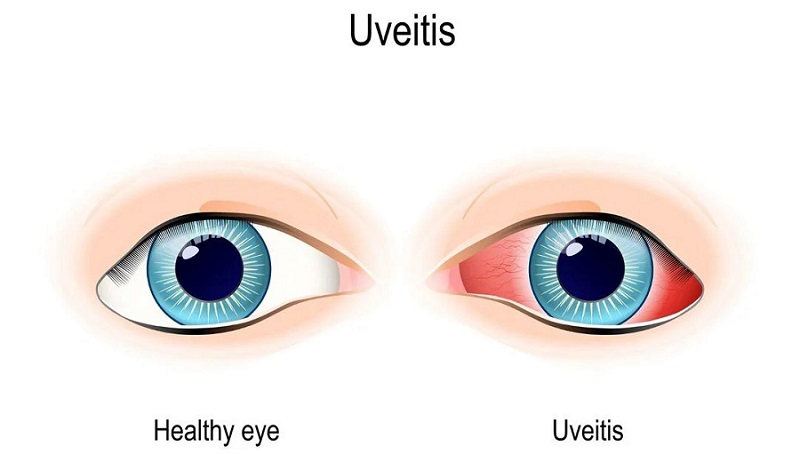What is Uveitis?
Uveitis is known as eye inflammation and is in the class of autoimmune diseases. In other words, it occurs as a reaction of the body to itself. It is in close relationship with different diseases, and rheumatic diseases are in close relationship with uveitis as it is one of the most common autoimmune diseases. For this reason, it is also known as “eye rheumatism” among the people.
There are 3 different layers in the human eye: the vessel, the nerve and the supporting layer. The vascular layer in the middle of the eye, which is responsible for its nutrition, is called the uvea. The uvea consists of iris, choroid, and ciliary body tissues.
The iris is the layer responsible for giving the eye color, nourishing the choroid, and the ciliary body is responsible for maintaining the shape of the lens, which is directly related to the iris and choroid. Inflammation in the uvea can affect all three of these layers.
What are The Types ?
The type of uveitis is classified according to where inflammation occurs in the uvea:
-
Anterior Uveitis:
Also called anterior uveitis. It is an inflammation of the anterior part of the uvea layer. Because the iris is located in the anterior part of the uvea, this inflammation usually affects the iris. Inflammation of the iris is called ‘iritis’. It can affect both eyes as well as in one eye. It is the most common type of uveitis in the community. Anterior uveitis is mostly seen in those without comorbidities.
-
Middle Uveitis:
It is also known as intermediate uveitis. The part of the iris and ciliary body is affected. Inflammation in this part is called iridocyclitis. Moderate uveitis can be seen mostly in people who do not have any additional disease, but can also be seen in people with autoimmune diseases such as multiple sclerosis (MS).
-
Posterior Uveitis:
In this condition, also called posterior uveitis, the posterior part of the uvea becomes inflamed.
This region includes the choroid part. And inflammation affects the choroid. Since the vessels in the choroid feed the retina, its inflammation can cause damage to the retina.
It can often cause more serious problems than other types of uveitis. Posterior uveitis can develop due to health problems such as infection and autoimmune disease. It is rarer than other types of uveitis.
-
Pan-Uveitis:
In this species, all regions of the uvea are affected. Therefore, in pan-uveitis, all the features of other types of uveitis can occur together. Behçet’s disease can be given as an example of diseases that cause pan-uveitis.
What Causes Uveitis?
In 30-40% of patients with uveitis, the cause of the disease cannot be determined exactly. Uveitis can be caused by factors such as viruses, fungi and parasites, or it can occur as a manifestation of a disease in the body in the eye. Therefore, it is necessary to investigate diseases with various assays. In addition, uveitis can occur in the presence of systemic diseases that we define as collagen tissue and autoimmune origin. Examples of these are Behçet’s disease, ankylosing spondylitis and rheumatoid arthritis.
- Behcet ‘s Disease
- Immune System Diseases
- Ulcerative Colitis
- Crohn’s Disease
- Ankylosing Spondylitis
- Rheumatic Diseases in Adults and Children
- Infections such as bacteria, viruses, parasites or fungi (tuberculosis, syphilis, herpes, toxoplasmosis, etc.)
- Eye Trauma
Uveitis is an extremely complex disease and may follow a different course in each patient. The treatment is as individual as the course of the disease. In the treatment to be applied, the dose of the drug must be determined by physicians who are experts and experienced in uvea.
What are The Symptoms of Uveitis?
Symptoms of uveitis may differ depending on the site of inflammation and may occur in one eye, in both eyes simultaneously or with a time difference.
If uveitis occurs in the anterior region of the eye, symptoms such as eye pain, discomfort from light and floating objects may occur. In addition, if the inflammation has intensely flowed into the eye, blurred vision may occur.
These symptoms can sometimes be accompanied by changes in the pupil of the eye. Because of the inflammation, the iris can stick to the lens or the edges. This condition is accompanied by redness of the eyes.
If the inflammation occurs in the middle region, floaters and blurred vision may occur in the eye.
If uveitis has occurred on the back surface of the eye, the problem of blurred vision and vision loss occurs with the sudden damage that may occur in the tissues. This type of uveitis can be detected as a result of in-depth examinations.
Other symptoms of uveitis are:
- Bleeding in the Eye,
- Glare,
- Watering in the Eyes,
- Sudden Flashes of Light,
- Reduction in Pupil,
- Vascularization and Edema in the Iris Layer of the Eye
- Headache,
- Symptoms such as heterochromia (different colors of the two eyes) can also be observed.
What are The Risk Factors ?
- Genetic Predisposition:
As a result of the predisposition to this disease in the genes transferred to the person from previous generations, the probability of uveitis increases in people.
- Infection:
Some disorders seen in different parts of the body also affect the eye and cause uveitis.
- Finding a Person’s Autoimmune or Inflammatory Disease History:
Diseases such as Behçet’s disease, ankylosing spondylitis, sarcoidosis, psoriatic arthritis, Crohn’s disease and ulcerative colitis increase the risk of uveitis.
- Finding a Person’s History of Eye Trauma:
Occurrence of conditions such as eye injury may cause uveitis, and sometimes even after the healing of the injury in the eye, uveitis may develop.
What are The Complications ?
- If left untreated, uveitis can lead to the following complications:
- Vision Loss,
- Increased Intraocular Pressure (Glaucoma),
- Optic Nerve Damage,
- Cataract Corneal Blurring Or Band Keratopathy,
- Retinal Complications such as Fluid Accumulation (Edema), Hole, Membrane Formation, Retinal Tear, Retinal Detachment in the Macula (Yellow Spot).
Which Tests are Performed in a Patient Suspected to Have Uveitis? How is The Diagnosis Made?
- Detailed eye and systemic disease history, detailed eye examination.
- Special eye examinations such as fluorescein angiography, optical coherence tomography (OCT) may be required.
- Depending on the characteristics of uveitis, the physician may order special examinations (PCR), blood tests, imaging examinations from the eye fluid or may request consultation from other specialties.
How is Uveitis Diagnosed?
Regardless of its severity, uveitis is an urgent disease. If it is delayed, the disease progresses and may cause permanent side effects such as deformities in the pupil, cataracts, and increased eye pressure due to inflammation. The first thing to do when the symptoms start is to be examined by an ophthalmologist experienced in uveitis. Being late for the first examination can cause permanent loss of vision.
Some types of uveitis have a typical appearance and can be diagnosed immediately. Even in these cases, advanced techniques such as angiography, ultrasonography, and ERG may be necessary to understand how the vision is threatened and to monitor the effectiveness of the treatment if the posterior part of the eye is involved. For example, angiography performed with a dye called ICG (indocyan green) can provide direct diagnostic information about the disease in suspicious cases. Then, joint research can be done with rheumatologists, pulmonologists, dermatologists and neurologists.
Behçet’s disease is a disease that appears in the form of recurrent “aphthae“-shaped sores in the mouth and genital area and causes uveitis in the eye. However, Behçet’s disease is a chronic inflammatory disease that can affect almost all systems in the body, causing involvement of joints, large and small vessels, respiratory, central nervous system and digestive system organs.
The signs and symptoms of the disease are seen in the form of exacerbations in the involved organs, and although some symptoms continue for a long time, there are periods that vary from person to person, where lesions are not seen and the person does not complain.
How is Treated?
- First of all, if uveitis is caused by a disease, that disease should be treated.
- In people with this disease, it is generally recommended to use sunglasses to protect against sensitivity to the sun or the negative effects of the sun on the disease.
- In this disease, a limitation in the patient’s activity is usually not required. However, it is useful to avoid work that requires attention, as some eye drops used by the patient for treatment enlarge the pupil and cause great difficulties in vision.
- Salt-free diet is applied in patients whose cortisone treatment is deemed appropriate.
- As medicine, eye drops, cortisone tablets and needles are the therapeutics used in the treatment of this disease.
- It is necessary to monitor the patients regularly during the treatment phase, because some important findings are encountered thanks to this monitoring. These important findings guide the treatment of the person. According to the findings, sometimes even a completely different treatment method can be applied to the person.

